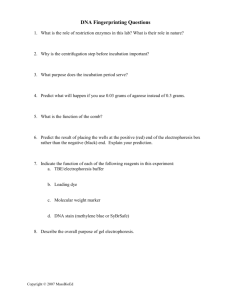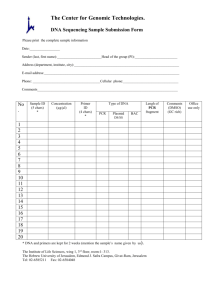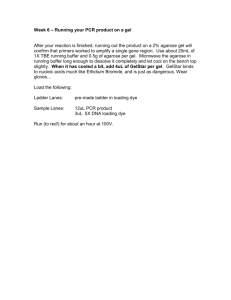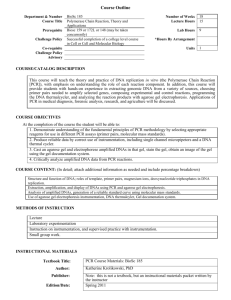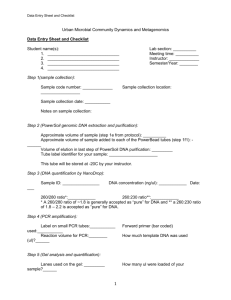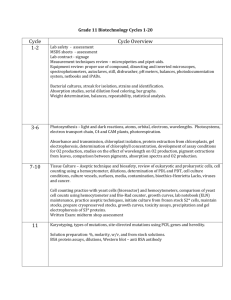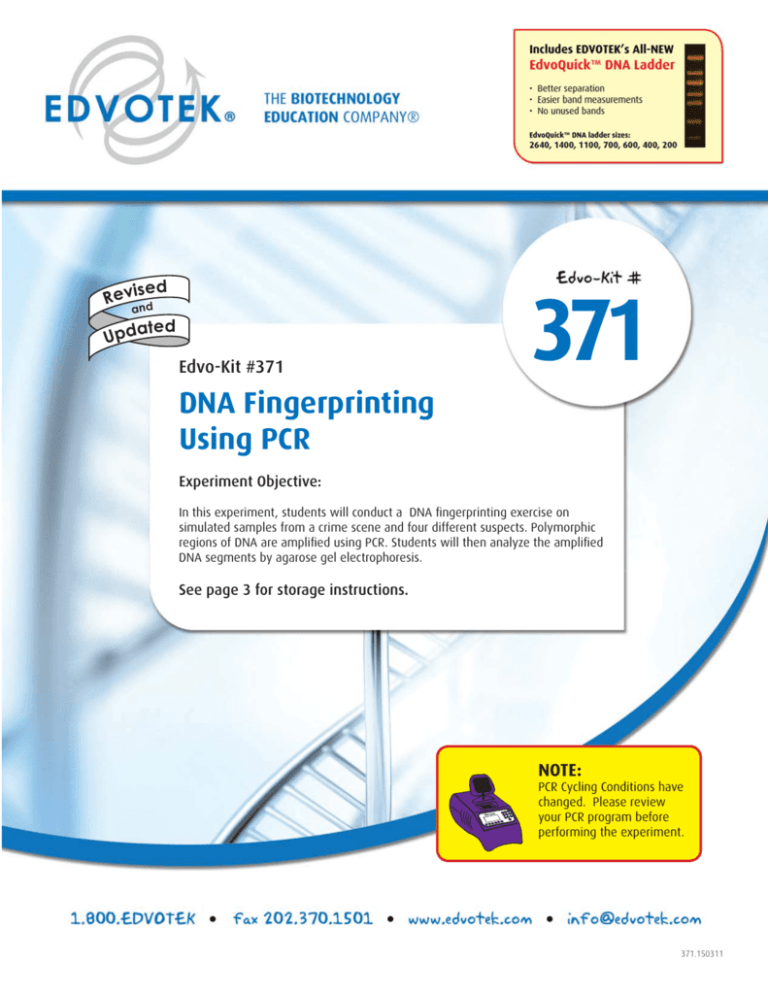
sed
Revi nd
a
ated
Upd
Edvo-Kit #371
371
DNA Fingerprinting
Using PCR
Experiment Objective:
In this experiment, students will conduct a DNA fingerprinting exercise on
simulated samples from a crime scene and four different suspects. Polymorphic
regions of DNA are amplified using PCR. Students will then analyze the amplified
DNA segments by agarose gel electrophoresis.
See page 3 for storage instructions.
NOTE:
PCR Cycling Conditions have
changed. Please review
your PCR program before
performing the experiment.
371.150311
EDVO-Kit
EDVO-Kit 371
371
DNA
DNAFINGERPRINTING
FINGERPRINTINGUSING
USINGPCR
PCR
Table of Contents
Page
Experiment Components
3
Experiment Requirements
4
Background Information
5
Experiment Procedures
Experiment Overview
Module I: PCR Amplification of Crime Scene & Suspect DNA
Module II: Separation of PCR Products by Electrophoresis
Module III: Staining Agarose Gels
Study Questions
9
10
11
13
15
Instructor's Guidelines
Pre-Lab Preparations
Experiment Results and Analysis
Study Questions and Answers
16
17
20
21
Appendices
22
Material Safety Data Sheets can be found on our website:
www.edvotek.com
EDVOTEK, The Biotechnology Education Company, and InstaStain are registered trademarks
of EDVOTEK, Inc. EdvoQuick, EdvoBead, FlashBlue, DuraGel, and UltraSpec-Agarose are
trademarks of EDVOTEK, Inc.
1.800.EDVOTEK • Fax 202.370.1501 • info@edvotek.com • www.edvotek.com
Duplication of any part of this document is permitted for non-profit educational purposes only. Copyright © 2006-2015
EDVOTEK, Inc., all rights reserved.
371.150311
2
EDVO-Kit 371
371
EDVO-Kit
DNA
DNAFINGERPRINTING
FINGERPRINTINGUSING
USINGPCR
PCR
Experiment Components
Components
A
Vial containing PCR EdvoBeads™
Storage
Check (√)
Room Temperature
❑
❑
❑
❑
❑
❑
❑
❑
Each PCR EdvoBead™ contains:
• dNTP Mixture
• Taq DNA Polymerase
• MgCl2
• Reaction Buffer
B
Primer mix concentrate
-20°C Freezer
C
EdvoQuick™ DNA Ladder
-20°C Freezer
D
DNA Template #1
-20°C Freezer
E
DNA Template #2
-20°C Freezer
F
DNA Template #3
-20°C Freezer
G
DNA Template #4
-20°C Freezer
H
TE Buffer
-20°C Freezer
Experiment #371 contains
enough reagents to amplify
25 DNA samples using the
Polymerase Chain Reaction.
This represents five complete sets of reactions.
Sample volumes are very
small. For liquid samples, it
is important to quick spin the
tube contents in a microcentrifuge to obtain sufficient
volume for pipeting. Spin
samples for 10-20 seconds at
maximum speed.
All experiment components
are intended for educational
research only. They are not
to be used for diagnostic or
drug purposes, nor administered to or consumed by
humans or animals.
NOTE: Component B is now supplied in concentrated form.
Reagents & Supplies (Included with this experiment)
Store all components below at room temperature.
Component
•
•
•
•
•
•
•
•
UltraSpec-Agarose™
Electrophoresis Buffer (50x)
10x Gel Loading Solution
InstaStain® Ethidium Bromide
FlashBlue™ Liquid Stain
Microcentrifuge Tubes
0.2 ml PCR tubes
Wax beads (for thermal cyclers without heated lid)
Check (√)
❑
❑
❑
❑
❑
❑
❑
❑
1.800.EDVOTEK • Fax 202.370.1501 • info@edvotek.com • www.edvotek.com
Duplication of any part of this document is permitted for non-profit educational purposes only. Copyright © 2006-2015
EDVOTEK, Inc., all rights reserved.
371.150311
3
DNA
DNAFINGERPRINTING
FINGERPRINTINGUSING
USINGPCR
PCR
EDVO-Kit
EDVO-Kit 371
371
Requirements (NOT included with this experiment)
•
•
•
•
•
•
•
•
•
•
•
•
•
Thermal cycler (EDVOTEK Cat. # 541 highly recommended)
Horizontal gel electrophoresis apparatus
D.C. power supply
Balance
Microcentrifuge
UV Transilluminator or UV Photodocumentation system (use if staining with InstaStain® Ethidium Bromide)
UV safety goggles
White light visualization system (optional - use if staining with FlashBlue™)
Automatic micropipets (5-50 μl) with tips
Microwave or hot plate
250 ml flasks or beakers
Hot gloves
Disposable laboratory gloves
1.800.EDVOTEK • Fax 202.370.1501 • info@edvotek.com • www.edvotek.com
Duplication of any part of this document is permitted for non-profit educational purposes only. Copyright © 2006-2015
EDVOTEK, Inc., all rights reserved.
371.150311
4
EDVO-Kit 371
371
EDVO-Kit
DNA
DNAFINGERPRINTING
FINGERPRINTINGUSING
USINGPCR
PCR
Background Information
VARIABILITY IN THE HUMAN GENOME ALLOWS FOR THE CREATION OF DNA FINGERPRINTS
The human genome is 99.9% identical between individuals. However, there are regions of variation within our
genome called polymorphisms. Each of us inherits a unique combination of polymorphisms from our parents. By
focusing on several polymorphic regions scientist can uncover a person’s “DNA fingerprint”. Like a regular fingerprint, a DNA fingerprint can be used to identify and distinguish between individuals. Because polymorphisms are
inherited, DNA fingerprints can also be used to determine family relationships. DNA fingerprinting is used for the
identification of missing persons and human remains, the determination of parentage, and the matching of criminal suspects to crime scenes.
DNA fingerprinting is used extensively in the field of forensic science. It establishes the probability that Sample X
from the crime scene came from Person Y. Sir Alex Jeffreys first developed this method in 1984 at the University
of Leicester, England. In 1986 analysis by Jeffreys led to the acquittal of Richard Buckland from murder charges. In
1987 Colin Pitchfork was the first criminal caught and convicted using DNA fingerprinting. Since then DNA analysis
has been used in thousands of convictions. Additionally, hundreds of convicted prison inmates have been exonerated from their crimes.
The goal of DNA fingerprinting is to analyze the genetic sample in a way that shows the tiny differences in the
DNA of different people. In the early days of DNA fingerprinting analysis, this was done using restriction fragment
length polymorphisms. Restriction enzymes recognize and cut DNA at specific nucleotide sequences. When added
to a sample, restriction enzymes create fragments of DNA that differ in length based on the presence of absence
of these sequences. These differences are visualized using gel electrophoresis followed by southern blotting and
hybridization to a labeled probe. An RFLP is demonstrated whenever the Southern blot pattern obtained with one
individual is different from the one obtained with another individual. This method is accurate but requires a considerable amount of starting material.
Figure 1A:
Homozygous
Condition
(Lane B)
Figure 1:
PCR Amplification
Products of D7S820
Primer 1
Paternal
A
B
C
DNA Standard
Marker (Lane A)
Maternal
Primer 1
1200bp
Paternal
Primer 2
1000bp
800bp
Maternal
600bp
400bp
Figure 1B:
Heterozygous
Condition
(Lane C)
200bp
Primer 2
1.800.EDVOTEK • Fax 202.370.1501 • info@edvotek.com • www.edvotek.com
Duplication of any part of this document is permitted for non-profit educational purposes only. Copyright © 2006-2015
EDVOTEK, Inc., all rights reserved.
371.150311
5
EDVO-Kit 371
DNA FINGERPRINTING USING PCR
Today, DNA fingerprinting is based on short repeat regions that can be analyzed even when they come from
a small amount of degraded DNA sample. Individuals possess regions within their chromosomal DNA that
are non-coding and that contain repeating units of nucleotides. These are called VNTRs (Variable Number
of Tandem Repeats) when the nucleotide repeats are 15 to 70 bp long and STR (Short Tandem Repeats)
when the nucleotide repeats are 2 to 6 bp long. VNTRs and STRs can repeat anywhere between three times
and a hundred times. Each repeat forms an allele of a specific size. An example of an STR is D7S820, found
on chromosome 7, which contains between 5 and 16 repeats of “GATA”. Humans have two copies of this
genetic locus – one from our biological mother and one from our biological father. This means we have two
alleles at this site. If both alleles are the same the individual is homozygous and if the alleles are different
the individual is heterozygous at D73820 (Figure 1). Because D73820 can be many different lengths, there
are hundreds of different allele combinations that can occur at this location.
The power of STR analysis comes from looking at multiple STR loci simultaneously. Thirteen independent loci
have been established as the standard for human identification - CSF1PO, FGA, TH01, TPOX, VWA, D3S1358,
D5S818, D7S820, D8S1179, D13S317, D16S539, D18S51 and D21S11. The probability of a random match
when all 13 loci are analyzed is 1 in 3 trillion. In 1990, the Federal Bureau of Investigation (FBI) established
the Combined DNA Index System (CODIS), based on these thirteen STRs (Figure 2). CODIS is a database
system which allows comparison of crime scene DNA to DNA profiles in a convicted offender and a forensic
(crime scene) index. A match of crime scene DNA to a profile in the convicted offender index indicates a
suspect for the crime, whereas a match of crime scene DNA to the forensic index (a different crime scene)
indicates a serial offender. CODIS has now been used to solve dozens of cases where authorities had not
been able to identify a suspect for the crime under investigation.
1
2
3
4
5
6
7
8
A
9
10
11
12
H
I
13
14
15
16
J
D
G
F
E
18
19
20
21
22
X
M
B
C
17
Figure 2:
13 CODIS Core STR Loci and Chromosomal Position
L
K
CODIS Sites:
A - TPOX
B - D3S1358
C - FGA
D - D5S818
E - CSF1PQ
F - D7S820
G - D8S1179
H - TH01
I - VWA
J - D13S317
K - D16S539
L - D18S51
M - D21S11
1.800.EDVOTEK • Fax 202.370.1501 • info@edvotek.com • www.edvotek.com
Duplication of any part of this document is permitted for non-profit educational purposes only. Copyright © 2006-2015
EDVOTEK, Inc., all rights reserved.
371.150311
6
Y
EDVO-Kit 371
DNA FINGERPRINTING USING PCR
CREATING A DNA FINGERPRINT FROM A CRIME
SCENE SAMPLE
Forensic DNA fingerprinting begins with the legal collection of biological evidence (often present as a stain) from
the crime scene or victim. The sample is treated with a
detergent to rupture (lyse) cell membranes, and the cellular DNA is extracted for further analysis (Figure 3). After
DNA is extracted from the sample, forensic scientists can
develop a DNA fingerprint. The DNA fingerprint from a
crime scene can then be compared to the DNA fingerprints
of different suspects. A match provides strong evidence
that the suspect was present at the crime scene.
CRIME SCENE
Body Fluid
Stain
Hair
Skin
Cells
SUSPECT #1
SUSPECT #2
Blood Draw
Blood Draw
Treat to release DNA
In today’s forensics laboratories, the polymerase chain reaction (or PCR) is used to create a DNA fingerprint. During
PCR, DNA is copied in vitro much like it is during replication in a dividing cell. While many enzymes are involved
in replication, PCR uses one enzyme and instead changes
the temperature to initiate different steps. The first step
for both PCR and replication is for two complementary
DNA strands to separate from one another. In PCR, this is
accomplished by heating the sample to 94°C, which breaks
the hydrogen bonds between the base pairs. This step is
known as denaturing.
In the second step of DNA replication, the enzyme Primase places small RNA primers on the single stranded
DNA to target the genome for replication by polymerase.
To replicate this in vitro, scientists create short, synthetic
pieces of DNA that target a specific part of the genome.
Primers have sequences unique to the regions above and
below the sequence of interest (Figure 1). These primers
bind to their specific DNA match and in turn serve as an
attachment site for DNA polymerase. In PCR, the sample
is cooled to an intermediate temperature, usually 40°C to
65°C, to allow binding of the two primers to the target
DNA in a process called annealing.
Perform PCR
to amplify
specific
polymorphic
regions
Crime Suspect Suspect
Scene
#2
#1
Suspect #2 matches
Crime Scene
Figure 3:
Extraction, Amplification, and Analysis of DNA
Samples
In the third step of replication and PCR, an enzyme called polymerase duplicates the DNA molecule by reading the
template DNA strand (starting from the primer) and assembling the appropriate nucleotides into a complimentary
strand. In PCR, this is accomplished by raising the temperature to 72°C, which is the optimal temperature for polymerase to synthesize the new complementary strand. An important difference between PCR and replication is that
in PCR a small section of the genome is amplified (as dictated by the primers) rather than the whole genome.
These three steps - denaturation, annealing, and extension - constitute one cycle of PCR. Each cycle doubles the
amount of targeted DNA (see Figure 4), exponentially increasing the amount of DNA in the sample. These three
distinct temperature steps are repeated many times. When these cycles are repeated 20-40 times, the amount of
target sequence increases to the point that it can be easily examined. To simplify this process, a specialized machine, called a “thermal cycler” or a “PCR machine”, was created to rapidly heat and cool the samples.
1.800.EDVOTEK • Fax 202.370.1501 • info@edvotek.com • www.edvotek.com
Duplication of any part of this document is permitted for non-profit educational purposes only. Copyright © 2006-2015
EDVOTEK, Inc., all rights reserved.
371.150311
7
EDVO-Kit 371
DNA FINGERPRINTING USING PCR
Target
5'
3'
3'
5'
5'
3'
5'
Primer 1
Denature 94°C
Anneal
primers to 45°C
Separation of two DNA strands
3'
Extension
72°C
Primer 2
5'
5'
5'
5'
3'
Extension
72°C
3'
5'
5'
Figure 4: Polymerase Chain Reaction
Because PCR occurs in a test tube, scientists must provide the key ingredients of nucleotides, primers, the
initial DNA template, and DNA polymerase. For PCR to be successful, this polymerase must be stable at high
temperatures so that it is not denatured each time the PCR sample is raised to 94°C. To combat this problem,
the thermostable DNA polymerase “Taq” was isolated from the bacterium Thermus aquaticus.
Following amplification, the PCR products are visualized and sized using gel electrophoresis. In gel electrophoresis the amplified product is added into depressions (or “wells”) within a gel, and then an electrical current
is passed through the gel. Because the sugar-phosphate backbone of DNA has a strong negative charge, the
current drives the DNA through the gel towards the positive electrode. On the molecular level, the gel contains small channels through which the DNA can pass. Small DNA fragments move through these holes easily,
but large DNA fragments have a more difficult time squeezing through the tunnels. Because molecules with
dissimilar sizes travel at different speeds, they become separated and form discrete “bands” within the gel.
After the current is stopped, the bands can be visualized using a stain that sticks to DNA (Figure 5). The loci’s
length is then calculated by comparing the distance the band traveled to a DNA ladder made up of several
known lengths. In forensic analysis this process of amplification, visualization, and measurement is repeated
for several loci.
In this experiment, students and teachers will design
their own crime scene and develop a plan to test their
crime-solving skills using PCR and gel electrophoresis.
A
B
(-)
1
2
3
4
(+)
5
6
(-)
1
2
3
4
5
(+)
Figure 5:
Overview of Agarose Gel Electrophoresis
1.800.EDVOTEK • Fax 202.370.1501 • info@edvotek.com • www.edvotek.com
Duplication of any part of this document is permitted for non-profit educational purposes only. Copyright © 2006-2015
EDVOTEK, Inc., all rights reserved.
371.150311
8
6
EDVO-Kit 371
371
EDVO-Kit
DNA
DNAFINGERPRINTING
FINGERPRINTINGUSING
USINGPCR
PCR
Experiment Overview
EXPERIMENT OBJECTIVE:
In this experiment, students will conduct a DNA fingerprinting exercise on simulated samples from a crime scene
and four different suspects. Polymorphic regions of DNA are amplified using PCR. Students will then analyze the
amplified DNA segments by agarose gel electrophoresis.
LABORATORY SAFETY
1.
Gloves and goggles should be worn routinely as good laboratory practice.
2.
Exercise extreme caution when working with equipment that is used in conjunction
with the heating and/or melting of reagents.
Wear gloves
and safety goggles
3.
DO NOT MOUTH PIPET REAGENTS - USE PIPET PUMPS.
4.
Exercise caution when using any electrical equipment in the laboratory.
5.
Always wash hands thoroughly with soap and water after handling reagents or biological materials in the
laboratory.
LABORATORY NOTEBOOKS:
Scientists document everything that happens during an experiment, including experimental conditions, thoughts
and observations while conducting the experiment, and, of course, any data collected. Today, you’ll be documenting your experiment in a laboratory notebook or on a separate worksheet.
Before starting the Experiment:
•
•
Carefully read the introduction and the protocol. Use this information to form a
hypothesis for this experiment.
Predict the results of your experiment.
During the Experiment:
•
Record your observations.
Module I: 70 min.
Amplification of Extracted
DNA by PCR
Module II: 50-70 min.
Separation of PCR Product
by Electrophoresis
After the Experiment:
•
•
Interpret the results – does your data support or contradict your hypothesis?
If you repeated this experiment, what would you change? Revise your hypothesis to reflect this change.
Module III : 10-30 min.
Staining Agarose
Gels
NOTE: Experimental times are
approximate.
1.800.EDVOTEK • Fax 202.370.1501 • info@edvotek.com • www.edvotek.com
Duplication of any part of this document is permitted for non-profit educational purposes only. Copyright © 2006-2015
EDVOTEK, Inc., all rights reserved.
371.150311
9
EDVO-Kit
EDVO-Kit 371
371
DNA
DNAFINGERPRINTING
FINGERPRINTINGUSING
USINGPCR
PCR
Module I: PCR Amplification of Crime Scene
and Suspect DNA
1.
2.
#2
3. Gently mix
#1
• 20 µl Primer Mix
• 5 µl Crime Scene DNA
• PCR EdvoBead™
CS
#4
#3
4.
1.
2.
3.
4.
5.
SPIN
5.
CS
This kit includes enough DNA
to set up five sets of PCR
samples.
If your thermal cycler does
not have a heated lid, it is
necessary to overlay the PCR
reaction with wax to prevent
evaporation. See Appendix B
for guidelines.
6.
LABEL 5 PCR tubes for: Crime scene PCR, Suspect #1 PCR, Suspect #2 PCR, Suspect
#3 PCR, and Suspect #4 PCR. Put your initials or group number on the tubes.
Each individual PCR reaction should be prepared as follows: ADD 20 μL primer
mix, 5 μL Crime Scene DNA and one PCR EdvoBead to the appropriately labeled
0.2 ml PCR tube. REPEAT for Suspect #1 through #4 DNA.
MIX each PCR sample. Make sure the PCR EdvoBeads are completely dissolved.
CENTRIFUGE to collect the samples at the bottom of the tubes.
AMPLIFY DNA using PCR:
PCR cycling conditions:
Initial denaturation 94°C for 3 minutes
94°C for 30 seconds
55°C for 65 seconds
30 cycles
72°C for 30 seconds
Final Extension 72°C for 4 minutes
6.
NOTES AND REMINDERS:
NOTE:
PCR Cycling Conditions have
changed. Please review your
PCR program before performing
the experiment.
ADD 5 μL 10x gel loading solution to each tube. PROCEED
to Module II: Electrophoresis of PCR product.
OPTIONAL STOPPING POINT
The PCR samples may be stored at -20°C for electrophoresis at a later time.
1.800.EDVOTEK • Fax 202.370.1501 • info@edvotek.com • www.edvotek.com
Duplication of any part of this document is permitted for non-profit educational purposes only. Copyright © 2006-2015
EDVOTEK, Inc., all rights reserved.
371.150311
10
EDVO-Kit 371
371
EDVO-Kit
DNA
DNAFINGERPRINTING
FINGERPRINTINGUSING
USINGPCR
PCR
Module II: Separation of PCR Products by Electrophoresis
1.
50
2.
3.
x
Concentrated
buffer
Distilled
water
1:00
Agarose
Wear gloves
and safety goggles
Flask
Caution! Flask will be HOT!
4.
5.
NOTES:
7 x 14 cm gels are
recommended. Each gel
will be used by 1 group
to analyze 1 crime scene
scenario. Place well-former template (comb) in
the first set of notches.
60°C
6.
WAIT
Pour
60°C
1.
2.
3.
4.
5.
6.
7.
If you are unfamiliar with
agarose gel prep and
electrophoresis, detailed
instructions and helpful
resources are available
at www.edvotek.com
20
min.
DILUTE concentrated (50X) buffer with distilled water to create 1X buffer (see Table A).
MIX agarose powder with 1X buffer in a 250 ml flask (see Table A).
DISSOLVE agarose powder by boiling the solution. MICROWAVE the solution on high
for 1 minute. Carefully REMOVE the flask from the microwave and MIX by swirling the
flask. Continue to HEAT the solution in 15-second bursts until the agarose is completely
dissolved (the solution should be clear like water).
COOL agarose to 60° C with careful swirling to promote even dissipation of heat.
While agarose is cooling, SEAL the ends of the gel-casting tray with the rubber end
caps. PLACE the well template (comb) in the appropriate notch.
POUR the cooled agarose solution into the prepared
gel-casting tray. The gel should thoroughly solidify
Table
Individual 1.0% UltraSpec-Agarose™ Gel
within 20 minutes. The gel will stiffen and become
less transparent as it solidifies.
Size of Gel
REMOVE end caps and comb. Take particular care
Concentrated
Distilled
TOTAL
Amt of
Casting tray Buffer (50x) + Water + Agarose =
Volume
when removing the comb to prevent damage to
7 x 7 cm
0.5 ml
24.5 ml
0.25g
25 ml
the wells.
A
7.
7 x 14 cm
1.0 ml
49.0 ml
0.50 g
50 ml
1.800.EDVOTEK • Fax 202.370.1501 • info@edvotek.com • www.edvotek.com
Duplication of any part of this document is permitted for non-profit educational purposes only. Copyright © 2006-2015
EDVOTEK, Inc., all rights reserved.
371.150311
11
EDVO-Kit 371
DNA FINGERPRINTING USING PCR
Module II: Separation of PCR Products by Electrophoresis
8.
9.
Pour
1X Diluted
Buffer
11.
10.
Wear gloves
and safety goggles
Reminder:
Before loading the samples,
make sure the gel is properly oriented in the apparatus
chamber.
8.
PLACE gel (on the tray) into electrophoresis chamber. COVER the gel with
1X electrophoresis buffer (See Table B for recommended volumes). The gel
should be completely submerged.
9. LOAD the entire sample (20-25 μL) into the well in the order indicated by
Table 1, at right.
10. PLACE safety cover. CHECK that the gel is properly oriented. Remember,
the DNA samples will migrate toward the positive (red) electrode.
11. CONNECT leads to the power source and PERFORM electrophoresis (See
Table C for time and voltage guidelines).
12. After electrophoresis is complete, REMOVE the gel and casting tray from the
electrophoresis chamber and proceed to Module III: STAINING Agarose Gels.
Table
B
1x Electrophoresis Buffer (Chamber Buffer)
EDVOTEK
Model #
Total Volume
Required
M6+
300 ml
M12
M36
Dilution
Table
C
Volts
6 ml
294 ml
400 ml
8 ml
392 ml
1000 ml
20 ml
980 ml
+
Lane
1
200 bp Ladder
2
Crime scene PCR
3
Suspect #1 PCR
4
Suspect #2 PCR
5
Suspect #3 PCR
6
Suspect #4 PCR
Time and Voltage Guidelines
(1.0% - 7 x 14 cm Agarose Gel)
Recommended Time
Distilled
Water
50x Conc.
Buffer
Table 1: Gel Loading
Minimum
Maximum
125
55 min.
1 hour 15 min.
70
2 hours 15 min.
3 hours
50
3 hours 25 min.
5 hours
1.800.EDVOTEK • Fax 202.370.1501 • info@edvotek.com • www.edvotek.com
Duplication of any part of this document is permitted for non-profit educational purposes only. Copyright © 2006-2015
EDVOTEK, Inc., all rights reserved.
371.150311
12
EDVO-Kit 371
371
EDVO-Kit
DNA
DNAFINGERPRINTING
FINGERPRINTINGUSING
USINGPCR
PCR
Module III-A: Staining Agarose Gels Using
InstaStain® Ethidium Bromide
1.
2.
3.
Moisten
the gel
4.
m
idiu
Eth
in®
Sta
sta
In
id
e
d in
Pen
ent
Pat
g
6.
-
STAIN
300 nm
5
min.
Ethid
nt Pending
U.S. Pate
m
InstaStain® Ethidiu
Bromide
U.S. Patent
1.
m
Bro
.
U.S
5.
InstaStain®
Preferred Method
Pending
Carefully REMOVE the agarose gel and casting tray from the electrophoresis chamber.
SLIDE the gel off of the casting tray on to a piece of plastic wrap on a flat surface.
DO NOT STAIN GELS IN THE ELECTROPHORESIS APPARATUS.
2.
MOISTEN the gel with a few drops of electrophoresis buffer.
3.
Wearing gloves, REMOVE and DISCARD the clear plastic protective sheet from the
unprinted side of the InstaStain® card(s). PLACE the unprinted side of the InstaStain®
Ethidium Bromide card(s) on the gel. You will need 2 cards to stain a 7 x 14 cm gel.
4.
With a gloved hand, REMOVE air bubbles between the card and the gel by firmly running your fingers
over the entire surface. Otherwise, those regions will not stain.
5.
PLACE the casting tray on top of the gel/card stack. PLACE a small weight (i.e. an empty glass beaker)
on top of the casting tray. This ensures that the InstaStain® Ethidium Bromide card is in direct contact
with the gel surface. STAIN the gel for 3-5 minutes.
6.
REMOVE the InstaStain® Ethidium Bromide card(s). VISUALIZE the gel using a long wavelength ultraviolet transilluminator (300 nm). DNA should appear as bright orange bands on a dark background.
Wear gloves
and safety goggles
BE SURE TO WEAR UV-PROTECTIVE EYEWEAR!
1.800.EDVOTEK • Fax 202.370.1501 • info@edvotek.com • www.edvotek.com
Duplication of any part of this document is permitted for non-profit educational purposes only. Copyright © 2006-2015
EDVOTEK, Inc., all rights reserved.
371.150311
13
EDVO-Kit
EDVO-Kit 371
371
DNA
DNAFINGERPRINTING
FINGERPRINTINGUSING
USINGPCR
PCR
Module III-B: Staining Agarose Gels Using FlashBlue™
1.
2.
10
x
Concentrated
FlashBlue™ Stain
Distilled
water
Wear gloves
and safety goggles
Flask
3.
5.
4.
STAIN
Pour
5
min.
(-)
1
2
3
4
5
6
DESTAIN
Pour
20
min.
(+)
1.
2.
3.
4.
5.
DILUTE 10 ml of 10x concentrated FlashBlue™ with 90 ml of water in a flask and MIX well.
REMOVE the agarose gel and casting tray from the electrophoresis chamber. SLIDE the gel off of the casting tray into a small, clean gel-staining tray.
COVER the gel with the 1x FlashBlue™ stain solution. STAIN the gel for 5 minutes. For best results, use an
orbital shaker to gently agitate the gel while staining. STAINING THE GEL FOR LONGER THAN 5 MINUTES
WILL REQUIRE EXTRA DESTAINING TIME.
TRANSFER the gel to a second small tray. COVER the gel with water. DESTAIN for at least 20 minutes
with gentle shaking (longer periods will yield better results). Frequent changes of the water will accelerate destaining.
Carefully REMOVE the gel from the destaining liquid. VISUALIZE results using a white light visualization
system. DNA will appear as dark blue bands on a light blue background.
Alternate Protocol:
1.
2.
3.
DILUTE one ml of concentrated FlashBlue™ stain with 149 ml dH2O.
COVER the gel with diluted FlashBlue™ stain.
SOAK the gel in the staining liquid for at least three hours. For best results, stain gels overnight.
1.800.EDVOTEK • Fax 202.370.1501 • info@edvotek.com • www.edvotek.com
Duplication of any part of this document is permitted for non-profit educational purposes only. Copyright © 2006-2015
EDVOTEK, Inc., all rights reserved.
371.150311
14
EDVO-Kit 371
371
EDVO-Kit
DNA
DNAFINGERPRINTING
FINGERPRINTINGUSING
USINGPCR
PCR
Study Questions
1.
What is polymorphic DNA? How is it used for identification purposes?
2.
What is an STR? Why is it used in law enforcement?
3.
What are the three steps in a PCR cycle and what does each step accomplish?
1.800.EDVOTEK • Fax 202.370.1501 • info@edvotek.com • www.edvotek.com
Duplication of any part of this document is permitted for non-profit educational purposes only. Copyright © 2006-2015
EDVOTEK, Inc., all rights reserved.
371.150311
15
DNA FINGERPRINTING USING PCR
INSTRUCTOR'S GUIDE
EDVO-Kit 371
Instructor's Guide
ADVANCE PREPARATION:
Preparation For:
What to do:
Module I:
PCR Amplification of
Crime Scene and
Suspect DNA
When:
Time Required:
Prepare and aliquot various
reagents (Primer, DNA
template, ladder, etc.)
One day to 30 min. before performing
the experiment.
30 min.
Program Thermal Cycler
One hour before performing
the experiment.
15 min.
Up to one day before performing
the experiment.
45 min.
Any time before the class period.
10 min.
Module II:
Separation of PCR
Product by
Electrophoresis
Prepare diluted TAE buffer (optional)
Module III:
Staining Agarose Gels
Prepare staining
components
Prepare molten agarose
and pour gel (optional)
1.800.EDVOTEK • Fax 202.370.1501 • info@edvotek.com • www.edvotek.com
Duplication of any part of this document is permitted for non-profit educational purposes only. Copyright © 2006-2015 EDVOTEK,
Inc., all rights reserved. 371.150311
16
EDVO-Kit 371
DNA FINGERPRINTING USING PCR
INSTRUCTOR'S GUIDE
Pre-Lab Preparations: Module I
There are four different DNA samples provided. Choose one sample to represent the crime scene sample. (The designated CS sample can be different
for different groups.) Make sure that one of the suspect DNAs is repeated as
the crime scene sample for the respective groups. Alternatively, students can
design their own crime scene scenario where they designate the DNAs for
the crime scene and suspects.
In our scenario, the DNA sample for suspect #2 is repeated as the crime
scene sample (see pg. 21).
NOTE:
There is enough material to
perform 25 PCR reactions and 5
gels. Students can be divided into
groups of five students per group
and samples from each group can
be run on a gel. There is enough
template DNA (Components
D-G) for each group to perform
a unique forensic crime scene
scenario.
Preparation of the DNA Template
1.
2.
Label 25 1.5 mL snap-top microcentrifuge tubes as follows:
5 - Crime Scene (CS)
5 - Suspect #1 (S1)
5 - Suspect #2 (S2
5 - Suspect #3 (S3)
5 - Suspect #4 (S4)
Dispense 7 uL of the DNA template into the appropriately labeled tube.
Remember to use one of the suspect samples as the crime scene sample.
Preparation of the Primer
1.
2.
3.
4.
FOR MODULE II
Each Student Group
should receive:
• 5 PCR tubes
• 5 PCR EdvoBeads™
• 7 μl Crime Scene DNA
• 7 μl Suspect #1 DNA
• 7 μl Suspect #2 DNA
• 7 μl Suspect #3 DNA
• 7 μl Suspect #4 DNA
• 120 μl Diluted Primer Mix
• 30 μl 10x Gel Loading Solution
Thaw the Primer Mix Concentrate (B) on ice.
Add 1 ml of TE Buffer (H) to the tube of Primer Mix Concentrate (B). Cap
tube and mix.
Aliquot 120 μl of the diluted Primer Mix into 5 labeled microcentrifuge tubes.
Distribute one tube of diluted Primer Mix to each student group.
Additional Materials
•
Dispense 30 μl of 10x Gel Loading Solution to each student group.
Programming the Thermal Cycler
The Thermal cycler should be programmed as outlined in
Module II in the Student’s Experimental Procedure.
•
•
NOTE:
PCR Cycling Conditions have
changed. Please review your
PCR program before performing
the experiment.
Accurate temperatures and cycle times are critical. A
pre-run for one cycle (takes approximately 3 to 5 min.) is
recommended to check that the thermal cycler is properly
programmed.
For thermal cyclers that do not have a heated lid, it is necessary to place a layer of wax above the PCR
reactions in the microcentrifuge tubes to prevent evaporation. See Appendix B for instructions.
1.800.EDVOTEK • Fax 202.370.1501 • info@edvotek.com • www.edvotek.com
Duplication of any part of this document is permitted for non-profit educational purposes only. Copyright © 2006-2015
EDVOTEK, Inc., all rights reserved.
371.150311
17
DNA FINGERPRINTING USING PCR
INSTRUCTOR'S GUIDE
EDVO-Kit 371
Pre-Lab Preparations: Module II
AGAROSE GEL ELECTROPHORESIS
NOTE:
This experiment requires one 1.0% agarose gel per student group. For best results, we recommend using a 7 x 14 cm gel. You can choose whether to prepare
the gels in advance or have the students prepare their own. Allow approximately 30-40 minutes for this procedure.
Individual Gel Preparation:
Each student group can be responsible for casting their own individual gel prior
to conducting the experiment. See Module II in the Student’s Experimental Procedure. Students will need 50x concentrated buffer, distilled water and agarose
powder.
Batch Gel Preparation:
To save time, a larger quantity of agarose solution can be prepared for sharing by
the class. See Appendix C.
Preparing Gels in Advance:
Gels may be prepared ahead and stored for later use. Solidified gels can be store
under buffer in the refrigerator for up to 2 weeks.
Do not freeze gels at -20º C as freezing will destroy the gels.
Accurate pipetting is critical for
maximizing successful experiment results. EDVOTEK PCR
experiments are designed for
students who have had previous
experience with micropipetting
techniques and agarose gel
electrophoresis.
If students are unfamiliar with
using micropipets, we recommended performing Cat. #S-44,
Micropipetting Basics or Cat.
#S-43, DNA DuraGel™ prior to
conducting this advanced level
experiment.
FOR MODULE II
Each Student Group
should receive:
• 50x concentrated buffer
• Distilled Water
• UltraSpec-Agarose™
• PCR Samples from Module I
• 30 μl EdvoQuick™ DNA ladder
Gels that have been removed from their trays for storage should be “anchored”
back to the tray with a few drops of molten agarose before being placed into the
tray. This will prevent the gels from sliding around in the trays and the chambers.
Additional Materials:
Each 1.0% gel should be loaded with the EdvoQuick™ DNA ladder and the PCR
samples from Module I.
•
Aliquot 30 μl of the EdvoQuick™ DNA ladder (C) into labeled microcentrifuge
tubes and distribute one tube of EdvoQuick™ DNA ladder per gel.
QuickGuide instructions and guidelines for casting various
agarose gels can be found our website.
www.edvotek.com/Quick-Guides
1.800.EDVOTEK • Fax 202.370.1501 • info@edvotek.com • www.edvotek.com
Duplication of any part of this document is permitted for non-profit educational purposes only. Copyright © 2006-2015
EDVOTEK, Inc., all rights reserved.
371.150311
18
EDVO-Kit 371
DNA FINGERPRINTING USING PCR
INSTRUCTOR'S GUIDE
Pre-Lab Preparations: Module III
MODULE III-A : STAINING WITH INSTASTAIN®
ETHIDIUM BROMIDE
Preferred Method
InstaStain® Ethidium Bromide provides the sensitivity of ethidium bromide while
minimizing the volume of liquid waste generated by staining and destaining a gel. An
agarose gel stained with InstaStain® Ethidium Bromide is ready for visualization in as
little as 3 minutes! Each InstaStain® card will stain 49 cm2 of gel (7 x 7 cm). You will
need 2 cards to stain a 7 x 14 cm gel.
FOR MODULE III-A
Each Student Group
should receive:
• 2 InstaStain® cards per
7 x 14 cm gel
Use a mid-range ultraviolet transilluminator (Cat. #558) to visualize gels stained with
InstaStain® Ethidium Bromide. BE SURE TO WEAR UV-PROTECTIVE EYEWEAR!
•
Standard DNA markers should be visible after staining even if other DNA samples
are faint or absent. If bands appear faint, repeat staining with a fresh InstaStain
card for an additional 3-5 min. If markers are not visible, troubleshoot for problems with electrophoretic separation (see Appendix A).
•
Ethidium bromide is a listed mutagen. Wear gloves and protective eyewear when
using this product. UV protective eyewear is required for visualization with a UV
transilluminator.
•
InstaStain® Ethidium Bromide cards and stained gels should be discarded using
institutional guidelines for solid chemical waste.
Wear gloves
and safety goggles
MODULE III-B: STAINING AGAROSE GELS WITH FLASHBLUE™
FlashBlue™ stain is optimized to shorten the time required for both staining and destaining steps. Agarose gels can be stained with diluted FlashBlue™ for 5 minutes and
destained for only 20 minutes. For the best results, leave the gel in liquid overnight.
This will allow the stained gel to “equilibrate” in the destaining solution, resulting in
dark blue DNA bands contrasting against a uniformly light blue background. A white
light box (Cat. #552) is recommended for visualizing gels stained with FlashBlue™.
•
Stained gels may be stored in destaining liquid for several weeks with refrigeration, although the bands may fade with time. If this happens, re-stain the gel.
•
Destained gels can be discarded in solid waste disposal. Destaining solutions can
be disposed of down the drain.
FOR MODULE III-B
Each Student Group
should receive:
• 10 ml 10X concentrated
FlashBlue OR 100 mL
1x diluted FlashBlue
• Small plastic tray or
weight boat
• Distilled or deionized
water
MODULE III: PHOTODOCUMENTATION OF DNA (OPTIONAL)
Once gels are stained, you may wish to photograph your results. There are many
different photodocumentation systems available, including digital systems that are
interfaced directly with computers. Specific instructions will vary depending upon the
type of photodocumentation system you are using.
1.800.EDVOTEK • Fax 202.370.1501 • info@edvotek.com • www.edvotek.com
Duplication of any part of this document is permitted for non-profit educational purposes only. Copyright © 2006-2015
EDVOTEK, Inc., all rights reserved.
371.150311
19
DNA FINGERPRINTING USING PCR
INSTRUCTOR'S GUIDE
EDVO-Kit 371
Experiment Results and Analysis
Lane
Sample
Size
1
EdvoQuick™ DNA Ladder
2
Crime Scene DNA
625
3
Suspect #1 DNA
400
4
Suspect #2 DNA
625
5
Suspect #3 DNA
200
6
Suspect #4 DNA
625, 400
ANALYSIS:
The above is an example outcome of this exercise, in which we chose suspect #2 to match the crime scene
DNA. Your results for the crime scene DNA will vary depending on which suspect was selected.
In criminal investigations, several known variable regions in DNA are analyzed to match crime scene and
suspect DNAs. In this exercise, we are analyzing one of these variable regions. A match between the crime
scene DNA and a suspect provides strong evidence that the suspect was present at the crime scene. After
analyzing the samples, a match was made between the crime scene DNA in lane 2 and Suspect #2 in lane 4.
This is strong evidence that suspect #2 was at the crime scene, but it does not prove that this suspect committed the crime.
The EdvoQuick™ DNA Ladder in lane 1 makes it possible to measure the size of the amplicons produced by
the PCR reactions in lanes 2-6.
1.800.EDVOTEK • Fax 202.370.1501 • info@edvotek.com • www.edvotek.com
Duplication of any part of this document is permitted for non-profit educational purposes only. Copyright © 2006-2015
EDVOTEK, Inc., all rights reserved.
371.150311
20
Please refer to the kit
insert for the Answers to
Study Questions
DNA FINGERPRINTING USING PCR
APPENDICES
EDVO-Kit 371
Appendices
A
EDVOTEK® Troubleshooting Guide
B
Preparation and Handling of PCR Samples With Wax
C
Bulk Preparation of Agarose Gels
Material Safety Data Sheets:
Now available for your convenient download on www.edvotek.com.
1.800.EDVOTEK • Fax 202.370.1501 • info@edvotek.com • www.edvotek.com
Duplication of any part of this document is permitted for non-profit educational purposes only. Copyright © 2006-2015 EDVOTEK,
Inc., all rights reserved. 371.150311
22
EDVO-Kit 371
DNA FINGERPRINTING USING PCR
APPENDICES
Appendix A
EDVOTEK® Troubleshooting Guides
PCR AND ELECTROPHORESIS
PROBLEM:
CAUSE:
ANSWER:
Make sure the heated lid reaches the appropriate temperature.
There is very little liquid
left in tube after PCR
Sample has evaporated
If your thermal cycler does not have a heated lid, overlay the
PCR reaction with wax (see Appendix B for details)
Make sure students close the lid of the PCR tube properly.
Pipetting error
Make sure students pipet 20 µL primer mix and 5 µL DNA
into the 0.2 mL tubes.
Ensure that the electrophoresis buffer was correctly diluted.
The gel was not prepared properly.
Gels of higher concentration (> 0.8%) require special attention
when melting the agarose. Make sure that the solution is
completely clear of “clumps” and glassy granules before
pouring gels.
The gel was not stained properly.
Repeat staining.
Malfunctioning electrophoresis unit or
power source.
Contact the manufacturer of the electrophoresis unit
or power source.
The gel was not stained for a sufficient
period of time.
Repeat staining protocol.
The ladder, control DNA,
and PCR products are
not visible on the gel.
After staining the gel,
the DNA bands are faint.
Repeat PCR with fresh PCR EdvoBeads™ and primers.
After staining, the ladder
is visible but no PCR
products are present.
PCR amplification was unsuccessful.
DNA bands were not
resolved.
Tracking dye should migrate at least 3.5 cm
(if using a 7x7 cm tray), and at least 6 cm
(if using a 7x14 cm tray) from the wells to
ensure adequate separation.
Be sure to run the gel at least 6 cm before staining
and visualizing the DNA (approximately one hour at
125 V).
DNA bands fade when
gels are kept at 4°C.
DNA stained with FlashBlue™ may
fade with time
Re-stain the gel with FlashBlue™
Ensure that the thermal cycler has been properly
programmed. See Module I for guidelines
1.800.EDVOTEK • Fax 202.370.1501 • info@edvotek.com • www.edvotek.com
Duplication of any part of this document is permitted for non-profit educational purposes only. Copyright © 2006-2015 EDVOTEK,
Inc., all rights reserved. 371.150311
23
DNA FINGERPRINTING USING PCR
APPENDICES
EDVO-Kit 371
Appendix B
Preparation & Handling of PCR Samples with Wax
ONLY For Thermal Cyclers WITHOUT Heated Lids
Using a wax overlay on reaction components prevents evaporation during the PCR process.
HOW TO PREPARE A WAX OVERLAY
1.
Add PCR components to the 0.2 ml PCR Tube as outlined in Module I.
2.
Centrifuge at full speed for five seconds to collect sample at bottom of the tube.
3.
Using clean forceps, add one wax bead to the PCR tube.
4.
Place samples in PCR machine and proceed with Module I.
PREPARING PCR SAMPLES FOR ELECTROPHORESIS
1.
After PCR is completed, melt the wax overlay by heating the sample at 94° C for three minutes or
until the wax melts.
2.
Using a clean pipette, remove as much overlay wax as possible.
3.
Allow the remaining wax to solidify.
4.
Use a pipette tip to puncture the thin layer of remaining wax. Using a fresh pipette tip, remove the
PCR product and transfer to a new tube.
5.
Add 5 μL of 10x Gel Loading Buffer to the sample. Proceed to Module II to perform electrophoresis.
1.800.EDVOTEK • Fax 202.370.1501 • info@edvotek.com • www.edvotek.com
Duplication of any part of this document is permitted for non-profit educational purposes only. Copyright © 2006-2015 EDVOTEK,
Inc., all rights reserved. 371.150311
24
EDVO-Kit 371
DNA FINGERPRINTING USING PCR
APPENDICES
Appendix C
Bulk Preparation of Agarose Gels
To save time, electrophoresis buffer and agarose gel solution can be prepared in larger quantities for sharing by the
class. Unused diluted buffer can be used at a later time and solidified agarose gel can be remelted.
BULK ELECTROPHORESIS BUFFER
Table
Bulk Preparation of Electrophoresis Buffer
D
Bulk preparation of 1X electrophoresis buffer is outlined in Table D.
50x Conc.
Buffer
Distilled
Water
Total Volume
Required
2,940 ml
3000 ml (3 L)
+
60 ml
BATCH AGAROSE GELS (1.0%)
Bulk preparation of 1.0% agarose gel is outlined in Table E.
1.
Use a 500 ml flask to prepare the diluted gel buffer
2.
Pour the measured UltraSpec-Agarose™ into the prepared buffer. Refer to Table E for the mass. Swirl to disperse clumps.
Table
Batch Preparation of
1.0% UltraSpec-Agarose™
E
Amt of
Agarose
+
50x Conc.
Buffer
+
Distilled
Water
=
Diluted
Buffer (1x)
3.0 g
6.0 ml
294 ml
300 ml
4.0 g
8.0 ml
392 ml
400 ml
3.
With a marking pen, indicate the level of solution volume on
the outside of the flask.
4.
Heat the agarose solution as outlined previously for individual
gel preparation. The heating time will require adjustment due to the larger
total volume of gel buffer solution.
5.
Cool the agarose solution to 60°C with swirling to promote even dissipation of heat. If evaporation has occurred, add distilled water to bring the
solution up to the original volume as marked on the flask in step 3.
6.
Dispense the required volume of cooled agarose solution for casting each
gel. Measure 25 ml for each 7 x 7 cm gel, 50 ml for each 7 x 14 cm gel.
For this experiment, 7 x 14 cm gels are recommended.
7.
Allow the gel to completely solidify. It will become firm and cool to the
touch after approximately 20 minutes. Then proceed with preparing the gel
for electrophoresis.
60˚C
Note:
The UltraSpec-Agarose™ kit
component is usually labeled
with the amount it contains.
Please read the label carefully. If the amount of agarose is not specified or if the
bottle's plastic seal has been
broken, weigh the agarose
to ensure you are using the
correct amount.
NOTE:
QuickGuide instructions
and guidelines for casting
various agarose gels can
be found our website.
www.edvotek.com/quickguides
1.800.EDVOTEK • Fax 202.370.1501 • info@edvotek.com • www.edvotek.com
Duplication of any part of this document is permitted for non-profit educational purposes only. Copyright © 2006-2015 EDVOTEK,
Inc., all rights reserved. 371.150311
25


